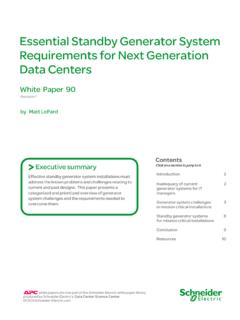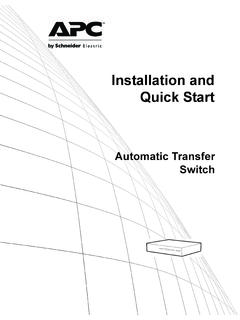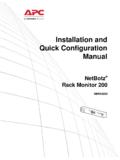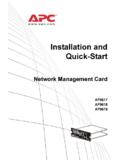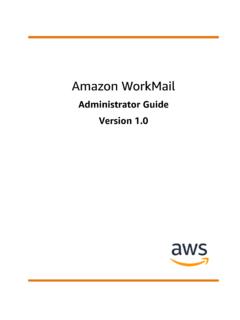Transcription of KVM Switch User’s Guide - - APC USA
1 user S GUIDEA nalog KVM SwitchContentsIIntroduction Analog KVM Switch --1 Product Description .. 1 Analog KVM Switch capabilities 1 Features of the Analog KVM Switch 1 Front panel (AP5202 shown) 2 Rear panel (AP5202 shown) 4 OSD Operation--6 Overview .. 6To activate the OSD main menu 6 OSD navigation 7 OSD main menu headings 8 OSD Functions.. 9 GOTO (F1) 9 LIST (F2) 10 SET (F3) 11 ADM (F4) 14 SKP (F5) 17 BRC (F6) 17 SCAN (F7) 18 LOUT (F8) 19 OSD default settings 20 Hot-Plugging--21 Description and Availability.. 21 Operation.. 22 Switching station positions 22 Hot-Plugging computer ports 22 Hot-Plugging console ports 22 Powering off and restarting 23 Port ID numbering 23 Port selection 24 user S GUIDEA nalog KVM SwitchIIHot Key Operation--25 Features.. 25 Purpose 25 Hot Key Port Control 25 Activating Hot Key Mode .. 26 Keystroke Sequences .. 27 Selecting the active port 27 Auto Scan 27 Skip mode 29 Hot Key Beeper control 29 Hot Key summary table 30 Firmware Upgrade--31 How to Upgrade Firmware.
2 31 Before you begin 31 Starting the upgrade 32To Recover From Lost Firmware 33 How to Recover from a Lost Password .. 34 Introduction Analog KVM Console Extender--35 Product Description .. 35 Front view of Analog KVM Console Extender 35 Operation.. 37 Product Information--39 Limited warranty 39 Warranty limitations 39 Obtaining service 40 Life-Support Policy .. 41 General policy 4141 Examples of life-support devices 41 Index--44 user S GUIDEA nalog KVM Switch1 Introduction Analog KVM SwitchProduct DescriptionAnalog KVM Switch capabilities Connect up to 31 additional Analog KVM Switches to control up to 512 computers from a single console. Add or remove switches or computers without having to remove power from the of the Analog KVM Switch The "keep-alive" feature assures all the keyboard and mouse connections work properly if the Analog KVM Switch temporarily loses power. KVM station positions are auto-sensed for serially-connected installations, which are indicated on the front panel LED.
3 Port names automatically reconfigure when the station sequence is changed. Two-level password security for an Administrator and up to four Users, with separate files for each, ensures that only authorized users can view and control the computers. No software is required; select a computer by using the On-Screen Display (OSD) menu or Hot Key combination. Auto Scan provides monitoring of connected computers. Use any PS/2-compatible mouse, Microsoft Intellimouse Explorer, or Logitech FirstMouse+. user S GUIDEA nalog KVM Switch2 Front panel (AP5202 shown)ItemDescription Port LEDsEach pair of Port LEDs provides status information about a corresponding computer port. Each port consists of a left (Online) and right (Selected) LED. The following list describes the LED light indicators: A green Online LED indicates the corresponding attached computer port is up and running. An orange Selected LED indicates the corresponding attached computer has the KVM focus.
4 Under normal conditions, the LED is steady. When accessing its port under Auto Scan Mode, the LED flashes. Each time the Analog KVM Switch begins to provide power, it performs a self-test. The Online and Selected LEDs blink once in succession during the self-test. Reset switchPress the recessed Reset Switch with a thin object (the end of a paper clip or ballpoint pen) to perform a system reset. Disable Remote buttonEnables or disables remote access to the console. Local and Remote LEDsIndicate which console is currently in use. Upgrade portThe firmware upgrade cable plugs into the RJ-11 connector and transfers firmware upgrade data from the Administrator's computer to the Analog KVM Switch . user S GUIDEA nalog KVM Switch3 Power LEDI ndicates when the Analog KVM Switch is receiving power. Station ID LED (16-port units only)Displays the station number of the Analog KVM Switch . Firmware upgrade reset switchRecovers operation if an attempt to upgrade firmware fails.
5 The reset Switch is in NORMAL position during normal operation. See To Recover From Lost Firmware for additional user S GUIDEA nalog KVM Switch4 Rear panel (AP5202 shown)ItemDescription Chain In port (AP5202 only)Serially connects one Analog KVM Switch to another. (This port is not used for the primary [Station 01] Analog KVM Switch in a cascaded setup.) Monitor connectorConnects to a VGA, SVGA, or Multisync monitor capable of the highest resolution that you plan to use on any computer in the installation. Computer connections Monitors connected computers; AP5201 can monitor up to eight, and AP5202 can monitor up to sixteen. Power inlet3-pin, AC power inlet. Remote consoleTo use a remote console, plug a CAT-5 cable into the RJ-45 connector. When both local and remote consoles are present, both can access the Switch (but not simultaneously). Push the Disable Remote button on the front of the unit to toggle between Remote access allowed and Remote access disabled.
6 When the remote console is accessing the Switch , you can view input data through the local console, but can make changes only through the remote console. When the local console is accessing the Switch , you can view input data through the remote console, but can make changes only through the local Local and Remote LEDs indicate which console is currently in use. When a remote extension unit is attached and receiving power, the two LEDs will alternately light when no one is accessing either console. user S GUIDEA nalog KVM Switch5 Keyboard connectorConnects to a PS/2-style keyboard. Mouse connectorConnects to a PS/2-style mouse. Chain Out port (AP5202 only)Serially connects one Analog KVM Switch to another user S GUIDEA nalog KVM Switch6 OSD OperationOverviewThe On-Screen Display (OSD) uses menu options to configure and control various operations such as editing port names and performing operations on multiple OSD also provides security for the KVM. For example, the Administrator can assign access privileges to Users, such as the right to access or view certain computers connected to the KVM.
7 The OSD main menu displays a list of function key controls, the username of the logged in user , connected computers, and symbols that indicate the status of a computer. The OSD includes a two-level password system: Administrator and activate the OSD main menu1. If you are already logged in, press the pre-assigned Hot Key (SCROLL LOCK) twice in rapid On initial startup, to access the OSD menus, do either of the following at the KVM login screen: Enter a valid username in the username field, press TAB, enter a valid password in the password field, and press ENTER. For a first-time KVM activation, or if the username and password have not been set, leave the username and password fields blank, and press ENTER. Optionally, you can assign the control key as the main menu Hot Key. See OSD HOTKEY. user S GUIDEA nalog KVM Switch7If you logged on as either Administrator or user , the OSD main menu is displayed. Administrator mode provides access to both Administrator and user functions and lets you set up operations (including future password authorization).
8 OSD navigationUse any of the following methods to navigate the OSD main menu screen: To dismiss the main menu and deactivate the OSD, press ESC, right-click the mouse, or click the X at the upper right-hand corner of the screen. To log off the OSD, press F8 or click F8 LOUT at the top of the screen, and answer YES to the prompt. To move up or down through the list one line at a time, press the up or down arrow keys, or click the up or down arrow symbols on the right scroll bar of the OSD. To move up or down through the list one screen at a time, press the PAGE UP (PGUP) or PAGE DOWN (PGDN) key. To activate a port, double-click its name in the list, or highlight the name and press ENTER. user S GUIDEA nalog KVM Switch8 OSD main menu headingsHeading DescriptionSN-PNList the Port ID numbers (Station Number - Port Number) for all computer ports on the installation. To access a computer, move the highlight bar over a computer in the list, and press arrowhead in a rectangle in this column indicates ports selected for Quick View (see SET QUICK VIEW PORTS).
9 A sun symbol in this column indicates that computers that are receiving power are currently user -defined unique port name (see EDIT PORT NAMES). user S GUIDEA nalog KVM Switch9 OSD FunctionsThe OSD provides a series of function keys to configure and control various computer operations. For example, you can Switch to any port, scan selected ports, and limit the list of ports to view. You can also manage port names or make OSD setting adjustments. To access any OSD function do one of the following: Press the desired function key on your keyboard. Click a function key menu option at the top of the main menu submenu provides additional functions related to your selected function ESC, or click the X button in the upper right corner of the OSD, to return to the previous menu level. GOTO (F1)To activate the GOTO function, press F1 or click the F1 menu option at the top of the main menu screen. GOTO allows you to Switch directly to a port by typing the port's name or the port ID.
10 The last line on the OSD screen prompts you to select by name or port ID. To use the name method: type 1 and the port name, then press ENTER. To use the port ID method: type 2 and the port ID, then press ENTER. To return to the OSD main menu screen without selecting a port, press ESC. user S GUIDEA nalog KVM Switch10 LIST (F2)To activate the LIST function, press F2 or click the F2 menu option at the top of the main menu screen. LIST allows you to broaden or narrow the scope of ports listed on the OSD. To activate a submenu option, move the highlight bar to the option, and press ENTER. An icon to the left of the menu option indicates your following table provides a description of each LIST submenu option: To quickly list the ports of only one KVM when you have multiple Analog KVM Switches in a cascading configuration, select GOTO, type the number 2, and enter the station ID of the desired KVM. For example, enter the station ID 20 to obtain a list of only the ports on KVM OptionDescriptionALLL ists all the ports on the VIEWL ists only the ports selected as Quick View Ports under F4 ADM (see SET QUICK VIEW PORTS).





